Guppy Poecilia Ret in Pairs White Tuxedo Guppies (1 Male + Female), Elegant Fish Perfect for Breeding, Enhance Your Tank with Stunning Colors and Peaceful Nature, Ideal for Community Aquariums
£18.49 Original price was: £18.49.£15.48Current price is: £15.48.
Welcome these beautiful creatures into your aquarium! The Guppy Poecilia Ret in Pairs White Tuxedo Guppies (1 Male + 1 Female) showcase stunning colors, adding elegance to any freshwater setup. Perfect for community tanks, they thrive with proper care and bring joy to aquarists seeking peaceful companions.
1077 in stock
Species Introduction
Essential Care Guide for Your Guppy Poecilia Ret in Pairs White Tuxedo Guppies (1 Male + Female)
| Optimal Living Conditions | |
|---|---|
| Water Temperature | 24-27°C (75-81°F) |
| pH Level | 6.5-7.5 |
| Water Hardness | 4-12 dKH |
| Minimum Tank Size | 80L (20 gal) |
| Salinity | Freshwater |
| Care Level | Beginner Friendly |
The Guppy, scientifically known as Poecilia reticulata, is a vibrant and elegant freshwater fish that originates from the warm, shallow waters of the Caribbean and parts of South America. These beautiful creatures are renowned for their stunning colors and patterns, particularly the striking White Tuxedo variety, which showcases a unique blend of white and black hues, resembling a formal tuxedo. Guppies are often found in slow-moving streams, ponds, and marshes, where they thrive in lush vegetation that provides both shelter and breeding grounds. Their adaptability to various water conditions makes them a popular choice for both novice and experienced aquarists alike. In their natural habitat, guppies play a crucial role in the ecosystem as they help control mosquito populations and serve as prey for larger fish. Welcome these beautiful creatures into your aquarium, and you will not only enjoy their aesthetic appeal but also contribute to the preservation of their species in captivity.
Care Requirements Dashboard
✓ Care Level: Easy
The Guppy, particularly the White Tuxedo variety, is considered an easy-to-care-for fish, making it ideal for beginners. Below are the essential care requirements:
| Care Requirement | Details |
|---|---|
| Tank Size | 10 gallons minimum for a pair |
| Water Temperature | 75-82°F (24-28°C) |
| pH Level | 6.8-7.8 |
| Hardness | 5-20 dGH |
| Lighting | Moderate to bright |
Natural Behavior & Temperament
Guppies are known for their peaceful nature and social behavior, making them ideal community fish. They are graceful swimmers, often seen darting around the tank, exploring their environment, and interacting with their tank mates. Guppies thrive in groups, and it is recommended to keep them in small schools to reduce stress and enhance their natural behaviors. Males are particularly active and display vibrant colors to attract females, showcasing their beautiful fins and tails during courtship rituals. This behavior not only adds visual interest to your aquarium but also contributes to the overall health and well-being of the fish. Their non-aggressive temperament allows them to coexist harmoniously with a variety of other freshwater species, making them a perfect addition to community tanks. However, it is essential to monitor their interactions with other fish to ensure a peaceful environment.
Tank Setup Guide
Creating an ideal environment for your White Tuxedo Guppies involves careful consideration of tank setup. Start with a minimum tank size of 10 gallons to provide ample swimming space. The substrate should be soft and smooth, such as fine gravel or sand, to prevent injuries to their delicate fins. Incorporate plenty of live plants, such as Java moss or Anubias, which not only enhance the aesthetic appeal but also provide hiding spots and breeding grounds. Additionally, consider adding decorations like driftwood or rocks to create territories and stimulate natural behaviors. Ensure that the tank is equipped with a reliable filtration system to maintain water quality, as guppies are sensitive to poor water conditions. A heater is also recommended to keep the water temperature stable within the ideal range. Lastly, provide adequate lighting to promote plant growth and highlight the vibrant colors of your guppies.
Water Quality Management
Maintaining optimal water quality is crucial for the health and longevity of your Guppy Poecilia Ret. Regular water changes of 20-30% weekly will help keep ammonia and nitrate levels low. Test the water parameters regularly using a reliable aquarium test kit. The ideal pH level for guppies ranges from 6.8 to 7.8, while water hardness should be maintained between 5 to 20 dGH. The temperature should be kept between 75-82°F (24-28°C) to ensure their comfort. It is essential to monitor for any fluctuations in these parameters, as guppies are sensitive to drastic changes. Additionally, consider using a water conditioner to remove harmful chemicals from tap water before adding it to the tank. This proactive approach to water quality management will create a thriving environment for your aquatic companions.
Feeding & Nutrition
Providing a balanced diet is essential for the health and vibrancy of your White Tuxedo Guppies. They are omnivorous, which means they enjoy a varied diet that includes high-quality flake food, frozen or live foods such as brine shrimp, daphnia, and bloodworms. A well-rounded diet will promote healthy growth, enhance coloration, and support overall vitality. It is recommended to feed them small amounts 2-3 times a day, ensuring that all food is consumed within a few minutes to prevent water quality issues. Additionally, consider incorporating vegetable matter into their diet, such as blanched spinach or spirulina, to provide essential nutrients. Regular feeding schedules will not only keep your guppies healthy but also encourage natural foraging behaviors.
Compatibility Guide
Guppies are known for their friendly disposition, making them excellent community fish. They can coexist peacefully with a variety of tank mates, including other small, non-aggressive species such as neon tetras, platies, and corydoras catfish. However, it is crucial to avoid keeping them with larger or aggressive fish that may see them as prey. Additionally, be cautious with other livebearers, as male guppies can exhibit territorial behavior. When selecting tank mates, consider the size, temperament, and swimming patterns of potential companions to ensure a harmonious environment. Below is a compatibility chart for your reference:
| Fish Species | Compatibility |
|---|---|
| Neon Tetra | Compatible |
| Platies | Compatible |
| Corydoras Catfish | Compatible |
| Betta Fish | Incompatible |
| Angelfish | Incompatible |
Health & Wellness
Keeping your Guppy Poecilia Ret healthy involves regular monitoring for signs of illness and stress. Common health issues include fin rot, ich, and swim bladder disease. To prevent these issues, maintain optimal water quality, provide a balanced diet, and avoid overcrowding in the tank. Regularly inspect your fish for any unusual behavior, such as lethargy, loss of appetite, or abnormal swimming patterns. If you notice any signs of illness, it is crucial to act quickly by isolating the affected fish and treating them in a separate quarantine tank. Additionally, ensure that your aquarium is free from sharp objects and toxic plants that could harm your guppies. By being proactive in their care, you can ensure a long and healthy life for your aquatic companions.
Breeding Information
Breeding guppies can be a rewarding experience, as they are prolific breeders. To encourage breeding, provide a separate breeding tank with plenty of hiding spots and a gentle filter. The ideal conditions for breeding include a temperature of 78-82°F (25-28°C) and slightly acidic water (pH 6.8-7.2). When the female is ready to spawn, she will exhibit a swollen belly and may seek out secluded areas in the tank. After a gestation period of about 28 days, the female will give birth to live fry. It is essential to remove the adult fish from the breeding tank after spawning, as they may eat their young. The fry should be fed finely crushed flakes or specialized fry food until they are large enough to consume regular food. With proper care, the fry will grow quickly and can be introduced to the main tank once they are big enough to avoid being eaten.
Acclimation Process
Introducing your new White Tuxedo Guppies to their new home requires a careful acclimation process to minimize stress and ensure a smooth transition. Begin by floating the sealed bag containing your guppies in the aquarium for about 15-20 minutes to equalize the temperature. After that, gradually introduce small amounts of aquarium water into the bag every 5 minutes for about an hour. This process helps the fish adjust to the water parameters in your tank. Once acclimated, gently release the guppies into the aquarium using a net to avoid adding any transport water. Monitor their behavior closely for the first few days and ensure they are adjusting well to their new environment. Proper acclimation is crucial for their health and well-being, allowing them to thrive in their new aquatic home.
Long-term Care
The lifespan of Guppy Poecilia Ret can range from 2 to 3 years with proper care. To ensure their longevity, maintain stable water conditions, provide a balanced diet, and keep their tank clean. Regular water changes and routine maintenance are essential to prevent the buildup of harmful toxins. Additionally, monitor their growth and behavior to identify any potential health issues early on. As your guppies mature, you may notice changes in their coloration and fin structure, particularly in males, who tend to become more vibrant as they reach maturity. By providing a nurturing environment, you can enjoy the beauty and companionship of your guppies for years to come.
Natural Habitat Recreation
Recreating the natural habitat of Guppy Poecilia Ret in your aquarium can enhance their well-being and promote natural behaviors. In the wild, guppies inhabit shallow waters with abundant vegetation, providing shelter and breeding grounds. To mimic this environment, incorporate live plants such as Java fern, hornwort, and floating plants like duckweed. These plants not only offer hiding spots but also help maintain water quality by absorbing excess nutrients. Additionally, consider adding smooth rocks and driftwood to create natural structures for the fish to explore. Ensure that the lighting is moderate to bright, as this will encourage plant growth and highlight the colors of your guppies. By recreating their natural habitat, you can provide a stimulating environment that supports their health and happiness.
Seasonal Care Adjustments
As seasons change, it is important to make necessary adjustments to your guppies’ care routine. In warmer months, ensure that the water temperature does not exceed 82°F (28°C) to prevent stress and potential health issues. Use a fan or aquarium chiller if necessary. Conversely, during colder months, maintain the water temperature within the ideal range using a reliable heater. Additionally, monitor the lighting duration, as natural daylight hours may vary with the seasons. Adjust the lighting schedule to provide a consistent photoperiod of 10-12 hours daily to promote healthy growth of plants and maintain the well-being of your guppies. By being attentive to seasonal changes, you can create a stable environment that supports the health of your aquatic companions.
Expert Tips
To ensure the best care for your Guppy Poecilia Ret, consider the following expert tips: First, always quarantine new fish before introducing them to your main tank to prevent the spread of diseases. Second, provide a varied diet to enhance coloration and overall health; consider high-quality flakes, freeze-dried foods, and occasional live foods. Third, regularly monitor water parameters using a test kit to catch any fluctuations early. Fourth, maintain a consistent feeding schedule, and avoid overfeeding to prevent water quality issues. Lastly, create a peaceful environment by avoiding aggressive tank mates and providing plenty of hiding spots. By following these tips, you can create a thriving habitat for your beautiful guppies.
Troubleshooting
Even with the best care, issues may arise in your aquarium. Common problems include fin rot, which can be caused by poor water quality or injuries; to treat this, improve water conditions and consider using a medicated treatment. Another issue is ich, a parasitic infection characterized by white spots on the fish; to combat this, raise the water temperature and add aquarium salt. If your guppies are exhibiting unusual behavior, such as hiding or lethargy, check for signs of stress or illness and take appropriate action. Regular maintenance and monitoring will help you catch these issues early, ensuring a healthy environment for your aquatic friends.
Scientific Background
The Guppy, or Poecilia reticulata, belongs to the Poeciliidae family and is one of the most studied freshwater fish in the world. Their popularity in the aquarium trade has led to extensive research on their genetics, behavior, and ecology. Guppies are known for their rapid reproduction and adaptability to various environments, making them an excellent model organism for scientific studies. Conservation efforts are essential to protect their natural habitats, as urbanization and pollution threaten their populations in the wild. By caring for guppies in captivity, aquarists can help raise awareness about the importance of preserving these beautiful creatures and their ecosystems.
Advanced Care Techniques
For experienced aquarists looking to enhance their care techniques for Guppy Poecilia Ret, consider implementing advanced methods such as selective breeding to enhance specific traits, like color patterns or fin shapes. Additionally, explore the use of live foods to stimulate natural hunting behaviors and improve overall health. Implementing a planted tank with a well-balanced ecosystem can also reduce maintenance efforts while providing a natural environment for your guppies. Lastly, consider using a CO2 injection system to promote plant growth, which in turn improves water quality and provides a more stable environment for your fish. These advanced techniques will not only enhance your guppy-keeping experience but also contribute to the overall health and beauty of your aquarium.
Frequently Asked Questions
Q: What tank size is required for Guppy Poecilia Ret?
For Guppy Poecilia Ret, a minimum tank size of 30 litres is recommended. This size allows ample space for swimming and reduces stress among the fish. Guppies are active swimmers and thrive in larger environments. Additionally, a well-planted tank with hiding spots and open swimming areas promotes their natural behaviour. It is advisable to avoid overcrowding; one male and one female is an ideal pairing to maintain a balanced environment. Regular water changes and filtration will help maintain water quality, contributing to the health and vibrancy of these lovely fish friends.
✓ Expert Tip
Consider adding live plants to your tank, as they can help maintain water quality while providing shelter for your guppies.
Q: What water parameters do Guppy Poecilia Ret require?
Guppy Poecilia Ret prefer slightly alkaline water with a pH level between 7.0 and 8.0. The water temperature should be maintained between 24°C to 28°C for optimal health. Regular testing of ammonia, nitrite, and nitrate levels is crucial, as guppies are sensitive to poor water quality. Aim for ammonia and nitrite levels at 0 mg/L and nitrates below 20 mg/L. Conducting weekly water changes of about 10-15% helps keep these parameters stable, ensuring a healthy environment for your aquatic companions.
✓ Expert Tip
Utilising a quality water conditioner can help neutralise harmful chemicals in tap water and create a safer environment.
Q: How often should I feed Guppy Poecilia Ret?
Guppy Poecilia Ret should be fed small amounts of high-quality flake or pellet food twice a day. It is vital to offer only what they can consume within a few minutes to prevent overfeeding and maintain water quality. Additionally, supplementing their diet with frozen or live foods such as brine shrimp or daphnia can enhance their colouration and overall health. Watch for any uneaten food, as decaying matter can lead to elevated ammonia levels.
✓ Expert Tip
Consider using a feeding ring to keep the food in one area, making it easier for your guppies to find and consume it.
Q: What are the best tank mates for Guppy Poecilia Ret?
Guppy Poecilia Ret are generally peaceful fish and can coexist with various species. Ideal tank mates include other small, non-aggressive fish such as neon tetras, rasboras, and Corydoras catfish. Avoid pairing them with larger or more aggressive species that may see them as food or stress them. Ensure that all fish share similar water parameter needs to create a harmonious environment. Always introduce new tank mates gradually and observe their interactions to prevent any potential issues.
✓ Expert Tip
Consider adding a few plants or decorations to create hiding spots, allowing all fish to establish territories and reducing stress.
Q: How do I properly acclimatise Guppy Poecilia Ret to my aquarium?
Acclimatising Guppy Poecilia Ret is crucial for their health. Begin by floating the sealed bag containing the fish in your aquarium for about 15-20 minutes. This allows the water temperature to equalise. Next, gradually introduce small amounts of aquarium water into the bag over an hour, mixing it with the water in the bag. After this period, gently transfer the guppies into the tank using a net, avoiding adding bag water to your aquarium to prevent contamination.
✓ Expert Tip
Perform this acclimatisation process in low light to reduce stress on the fish during their transition.
Q: What are the signs of healthy Guppy Poecilia Ret?
Healthy Guppy Poecilia Ret exhibit vibrant colours and clear, bright eyes. They should be active, swimming freely and displaying natural behaviours such as exploring their environment. Look for a healthy appetite; they should eagerly approach food during feeding times. Additionally, check for smooth, unblemished fins and skin, as any signs of lesions or fraying can indicate health issues. Regular observation will help you quickly spot any changes in their behaviour or appearance.
✓ Expert Tip
Keep a journal to track your guppies’ health and behaviour, which can help you identify any changes over time.
Q: How do I successfully breed Guppy Poecilia Ret?
Breeding Guppy Poecilia Ret is relatively straightforward. Ensure you have a healthy male and female pair in a spacious, well-maintained tank. Provide plenty of hiding spots using plants or decorations, as this helps protect fry from being eaten. Maintain a temperature of around 26°C and ensure water quality is optimal. Once the female is pregnant, she will display a darker gravid spot near her abdomen. After 4-6 weeks, she will give birth to live fry. Remove the fry to a separate tank or provide more cover in the breeding tank to increase their chances of survival.
✓ Expert Tip
Consider using a breeding box to separate the fry from adults until they grow large enough to fend for themselves.
Q: What temperature should I maintain for Guppy Poecilia Ret?
The ideal temperature range for Guppy Poecilia Ret is between 24°C and 28°C. This temperature range mimics their natural habitat in warm freshwater environments. Maintaining a stable temperature is crucial, as fluctuations can lead to stress and illness. It is advisable to use a reliable aquarium heater and thermometer to monitor the water temperature regularly. Any significant temperature changes should be avoided, as they can adversely affect your guppies’ health.
✓ Expert Tip
Consider placing your aquarium in a stable environment, away from direct sunlight or drafts, to help maintain a consistent temperature.
Q: How long do Guppy Poecilia Ret typically live in captivity?
In captivity, Guppy Poecilia Ret typically live for 2 to 3 years, although some individuals may live longer with proper care. Factors influencing their lifespan include water quality, diet, and overall tank conditions. Providing a stress-free environment with good filtration, regular water changes, and a varied diet can help maximise their lifespan. It is vital to monitor their health and promptly address any issues to ensure they live a long and healthy life.
✓ Expert Tip
Keep your aquarium free from stressors and provide a balanced diet to help your guppies thrive for as long as possible.
Q: What type of substrate is most suitable for Guppy Poecilia Ret?
For Guppy Poecilia Ret, a fine-grained substrate such as sand or smooth gravel is ideal. This type of substrate allows for easy cleaning and prevents debris from accumulating, which can lead to poor water quality. Additionally, it provides a comfortable environment for guppies to explore and dig. If you opt for a planted tank, ensure the substrate is nutrient-rich to support plant growth, as live plants contribute to a healthier ecosystem for your fish friends.
✓ Expert Tip
Regularly vacuum the substrate during water changes to maintain cleanliness and prevent harmful build-up.
Q: What behavioural patterns should I expect from Guppy Poecilia Ret?
Guppy Poecilia Ret are known for their lively and sociable behaviour. They often swim in groups, displaying a playful nature as they explore their environment. Males are particularly active, often engaging in courtship displays towards females. You may observe them chasing one another or performing rapid movements. They are generally non-aggressive and thrive in a community tank setting. Providing a well-structured environment with plants and hiding spots encourages their natural behaviours, making for a vibrant aquarium.
✓ Expert Tip
Introduce a variety of plants and decorations to create a stimulating environment that promotes natural behaviours.
Q: How can I prevent common diseases in Guppy Poecilia Ret?
Preventing diseases in Guppy Poecilia Ret involves maintaining optimal water quality and a stress-free environment. Regular water changes, appropriate filtration, and monitoring water parameters are essential. Quarantine any new fish before introducing them to your main tank to avoid introducing pathogens. Additionally, providing a balanced diet can strengthen their immune system. Watch for signs of illness, such as lethargy or changes in appearance, and address any issues promptly. Maintaining a clean environment and avoiding overcrowding further supports their health.
✓ Expert Tip
Consider using a high-quality water conditioner and performing regular tank maintenance to bolster your guppies’ health.
Q: What lighting conditions do Guppy Poecilia Ret prefer?
Guppy Poecilia Ret thrive in moderate lighting conditions. A well-lit tank enhances their vibrant colours and encourages plant growth. However, avoid direct sunlight, which can lead to algae blooms and temperature fluctuations. A standard aquarium light with a timer set for 8-10 hours a day will provide sufficient light without stressing the fish. Incorporating floating plants can help diffuse the light intensity, creating a comfortable environment for your guppies.
✓ Expert Tip
Regularly clean your aquarium light to maintain optimal brightness and ensure your plants receive adequate light for growth.
Q: How do I recognise stress in Guppy Poecilia Ret?
Recognising stress in Guppy Poecilia Ret is vital for their wellbeing. Signs of stress may include excessive hiding, erratic swimming patterns, or clamped fins. Additionally, they may lose their vibrant colouration or display signs of aggression towards tank mates. Sudden changes in behaviour, such as refusal to eat or lethargy, are also indicators of stress. Regular observation will help you identify these changes early, allowing you to address any underlying issues promptly.
✓ Expert Tip
Create a calm environment with plenty of hiding spots to help reduce stress levels in your guppies.
Q: What natural habitat conditions should I replicate for Guppy Poecilia Ret?
To replicate the natural habitat of Guppy Poecilia Ret, aim for a well-planted tank with plenty of hiding spaces. In the wild, they inhabit shallow, freshwater environments with abundant vegetation. Incorporating live plants, such as java moss or anubias, will help mimic their natural surroundings. Maintain slightly warm water temperatures and stable pH levels, and ensure a gentle water flow to simulate their native habitat. This will contribute to their overall health and wellbeing.
✓ Expert Tip
Regularly observe your guppies and adjust their environment as needed to ensure they feel secure and thrive.

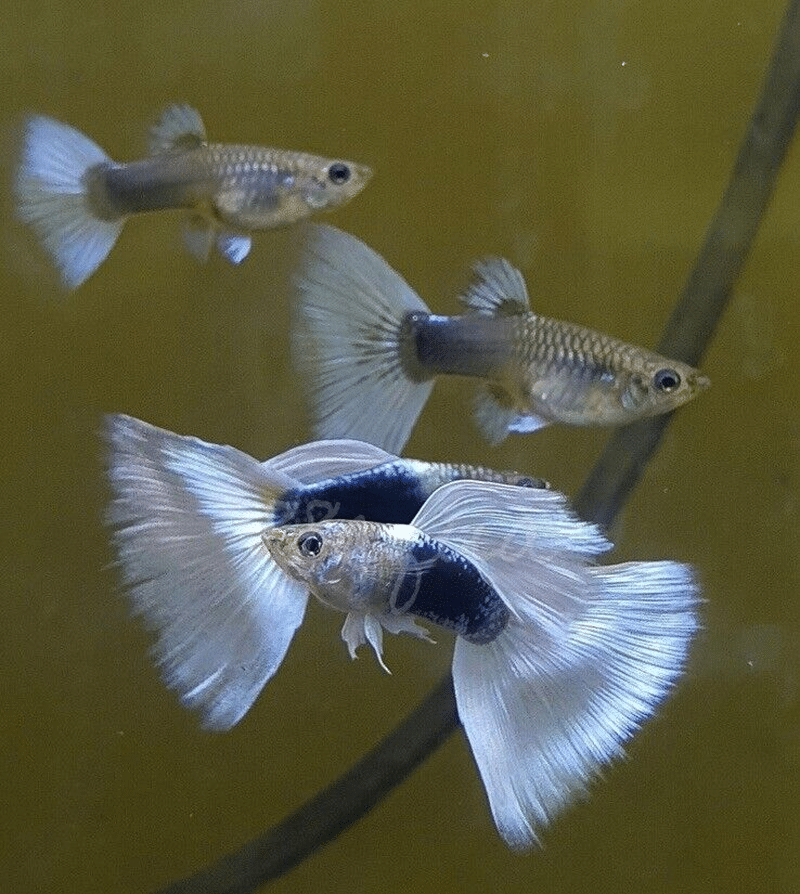
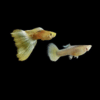
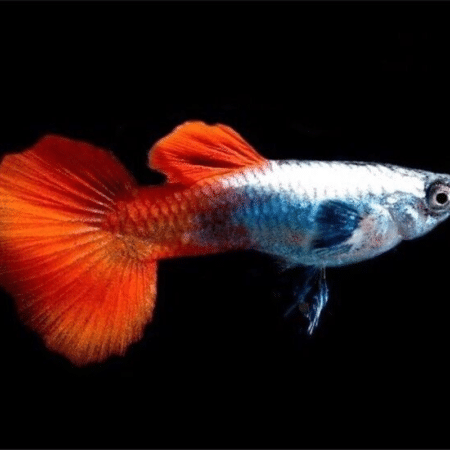

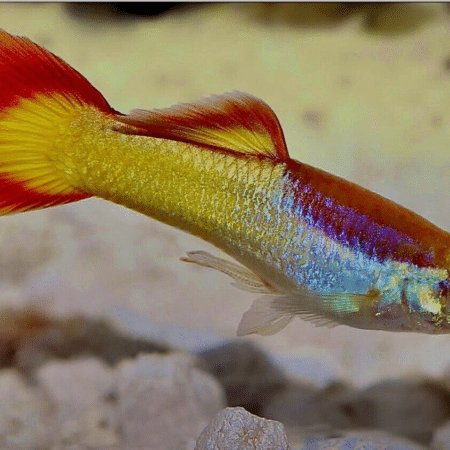

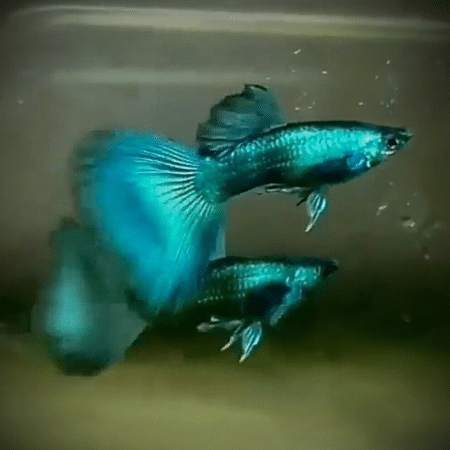

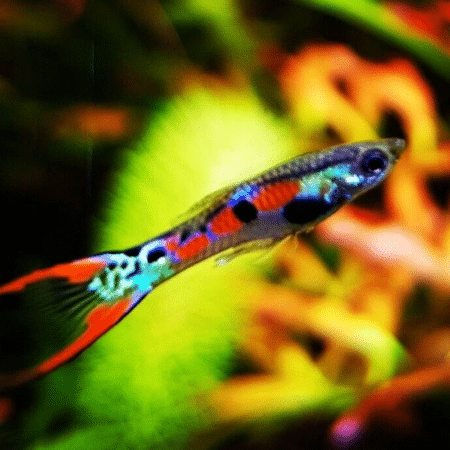




Emily Carter (verified owner) –
I’ve been an aquarium enthusiast for over five years and recently decided to expand my freshwater fish collection. After doing some research, I came across these White Tuxedo Guppies and couldn’t resist getting a pair! After just two months of having them in my 20-gallon tank, I can confidently say they are a delightful addition. Their shimmering tails and unique color patterns never cease to amaze me, and they have such vibrant personalities!
What I appreciate most is how easy they are to care for. They are quite hardy and seem to thrive with the high-quality fish food I’ve been using. I’ve noticed they’re very active, swimming around and interacting with the other fish, which adds so much liveliness to the tank. One minor concern is that they can be a little nippy with smaller fish, so I’d recommend ensuring they’re in a community tank with compatible species.
If you’re looking for aquarium fish that are not just beautiful but also bring joy, I wholeheartedly recommend these guppies. Their cheerful presence and easy-going nature make them perfect for both beginners and seasoned aquarists! Overall, I’m thrilled with my purchase and will definitely consider adding more in the future!
Emily Carter (verified owner) –
I recently purchased the White Tuxedo Guppies (1 male + 1 female) and I couldn’t be happier! These little guys have been in my 20-gallon freshwater tank for about three weeks now, and they’ve added a delightful splash of color and personality. Their vibrant white and black markings are truly stunning and stand out beautifully against the lush green plants I have.
What I love most is their peaceful nature; they get along well with my other tropical fish, making them a perfect addition to my community tank. I chose these guppies for breeding, and they’ve already started interacting in ways that suggest they’re quite comfortable. I’ve noticed the female is getting rounder, which is exciting!
Shipping was quick, and they arrived healthy and active, which is always a relief. If you’re a caring fish parent like me, you’ll appreciate how robust and lively they are. My only minor concern was adjusting the tank’s pH level, but that’s easily manageable. I highly recommend these guppies to anyone looking to enhance their aquarium with beautiful and friendly fish. They’re perfect for both beginners and seasoned hobbyists!